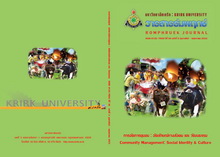การจัดการและการมีส่วนร่วมเพื่อการพัฒนาแหล่งท่องเที่ยว เชิงวัฒนธรรม: กรณีศึกษากลุ่มชาติพันธุ์ไทยพวน อำเภอบ้านหมี่ จังหวัดลพบุรี
Main Article Content
Abstract
การวิจัยครั้งนี้เป็นการวิจัยเชิงปริมาณ และคุณภาพเน้น การวิจัยแบบมีส่วนร่วม (participatory research) ใช้เทคนิคการเก็บรวบรวมข้อมูลหลายวิธี ได้แก่ การศึกษาค้นคว้าจากเอกสาร (documentary research) การสัมภาษณ์เบื้องต้น (preliminary interview) การสัมภาษณ์เชิงลึก (in-depth interview) การสนทนากลุ่ม (focus group discussion) การใช้แบบสอบถาม(questionnaire) และการจัดเวทีชุมชน (community forum) ทำการวิเคราะห์ข้อมูลเชิงปริมาณโดยใช้สถิติพรรณนา (descriptivetatistics)ได้แก่ ร้อยละ (percentage) ค่าเฉลี่ย (mean) และส่วนเบี่ยงเบนมาตรฐาน (standard deviation) ส่วนข้อมูลเชิงคุณภาพใช้การวิเคราะห์เนื้อหา (content analysis)
ผลการวิจัยพบว่า
1. กลุ่มชาติพันธุ์ไทยพวน อำเภอบ้านหมี่ จังหวัดลพบุรี ยังคงมีการสืบสานศิลปวัฒนธรรมและประเพณีที่สำ คัญบางอย่างอย่างต่อเนื่องหน่วยงานของรัฐมีการส่งเสริมศิลปวัฒนธรรมของชาวไทยพวนโดยมอบนโยบายผ่านสำนักงานวัฒนธรรมจังหวัดลพบุรีและองค์การบริหารส่วนตำบล มีการสนับสนุนงบประมาณสำหรับ การจัดกิจกรรมเชิงวัฒนธรรมของชาวไทยพวนเป็นประจำ ทุกปีแต่ไม่เพียงพอ
2. การมีส่วนร่วมในการจัดการท่องเที่ยวเชิงวัฒนธรรมพบว่า ส่วนใหญ่มีการวางแผนร่วมกันระหว่างหน่วยงานระดับอำเภอ และองค์การบริหารส่วนตำบล เน้นการจัดกิจกรรมเชิงวัฒนธรรมไทยพวนเพื่อส่งเสริมการท่องเที่ยว ในเขตอำเภอบ้านหมี่ และเกือบทุกตำบลที่เป็นพื้นที่ศึกษามีการจัดตั้งองค์กรที่พร้อมจะให้ความ ร่วมมือหากมีผู้นำในการพัฒนาชุมชนให้กลายเป็นแหล่งท่องเที่ยวเชิงวัฒนธรรมของกลุ่มชาติพันธุ์ไทยพวนในอนาคต
3. ความต้องการมีส่วนร่วมในการจัดการแหล่งท่องเที่ยวเชิงวัฒนธรรมของกลุ่มชาติพันธุ์ไทยพวน เขตอำ เภอบ้านหมี่ จังหวัดลพบุรี ในภาพรวมและทุกรายด้านอยู่ในระดับมากได้แก่ ด้านการวางแผน การจัดองค์การ การใช้ภาวะการนำ การควบคุม และการจัดการท่องเที่ยว นอกจากนี้ นักท่องเที่ยวมีความคิดเห็นต่อการจัดการการท่องเที่ยวเชิงวัฒนธรรม และการมีส่วนร่วมของกลุ่มชาติพันธุ์ไทยพวนในภาพรวมอยู่ในระดับปานกลาง เมื่อพิจารณารายด้าน พบว่า ด้านการมีส่วนร่วมของชุมชนอยู่ในระดับมากที่เหลืออีก 3 ด้าน ได้แก่ด้านสิ่งดึงดูดใจ ด้านสิ่งอำนวยความสะดวก และด้านการเข้าถึงแหล่งท่องเที่ยวมีความคิดเห็นในระดับปานกลาง
4. แนวทางการจัดการพัฒนาแหล่งท่องเที่ยวเชิงวัฒนธรรมของกลุ่มชาติพันธุ์ไทยพวน อำเภอบ้านหมี่ จังหวัดลพบุรี นั้นมีการจัดตั้งคณะกรรมการดำเนินงานอย่างจริงจังโดยภาครัฐมีการสนับสนุนงบประมาณอย่างเพียงพอ
5. การพัฒนาให้เป็นแหล่งท่องเที่ยวเชิงวัฒนธรรมของกลุ่มชาติพันธุ์ไทยพวนอำเภอบ้านหมี่ จังหวัดลพบุรี ทำ ให้เกิดผลกระทบเชิงบวก ได้แก่ คนในชุมชนมีรายได้เพิ่มขึ้น ชุมชนมีการพัฒนาด้านโครงสร้างพื้นฐาน เช่น ถนน สาธารณูปโภคต่างๆและเป็นการอนุรักษ์ และเผยแพร่ศิลปวัฒนธรรมของชาวไทยพวนให้เป็นที่รู้จักและยอมรับของคนทั่วไป ส่วนผลกระทบเชิงลบ ได้แก่ ปัญหาสภาวะสิ่งแวดล้อมของชุมชนเช่นการเพิ่มขึ้นของขยะมูลฝอย เกิดมลพิษทางอากาศเป็นต้น
Management and Participation for Cultural Tourism Development : A Case Study of Thai Phuan Ethnic Group, Ban Mi District, Lop Buri Province
The purposes of this research were (1) to study contexts of Thai Phuan ethnic group, Ban Mi district, Lop Buri province ; (2) to provide Thai Phuan community participating in knowledge management; and (3) to guide Thai Phuan ethnic group, Ban Mi district, Lop Buri province to develop cultural tourism resources. The samples in this research divided into of 5 groups : (1) 10 administrators for in-depth interview and focus groups (2) 15 communityleaders for preliminary interview, focus group and community forum; (3) 15 Thai Phuan successors and members of the community who specialized in history of Thai Phuan ethnic group for focus group and community forum ; (4) residents in Tambol Bangluey, Chiang nga, Bansai, Phonthong, Hinpag for the total of 391 persons for giving the opinion on the need for management and participations for managing cultural tourism resources ; and (5) 400 tourists for providing the opinion toward management and participation for cultural tourism development. The research used both quantitative and qualitative method. The data were collected through documentary research, preliminary interview, in-depth interview, focus group, community forum and questionnaires. The quantitative data were systematically analyzed by percentage, mean, and standard deviation and the qualitative data were analyzed by content analysis. The research findings were as follows :
1. Thai Phuan ethnic group at, Ban Mi district, Lop Buri province continually inherited and handed down the culture and tradition to their next generation. Government organizations have promoted Thai Phuan’s culture by entrusting policy through the office of Lop Buri Culture Commission and local organizations. They had allocated annual budget for conducting activities related to culture but the budget was not enough.
2. As for participating in cultural tourism development, it was found that there were cooperative planning between district organizations and local organizations. The planning focused on activities to support Thai Phuan cultural tourism development. Most of Tambols in the studied areas, had established organizations that their functions related to Thai Phuan cultures.The organizations were ready to participate in developing community to be Thai Phuan tourism resources in future.
3. The needs of residents for taking part in management and participation for cultural tourism development in overall were rated at a high level. With respect to individual aspects of the study, planning, organizing, leading, controlling, and tourism management were also rated at a high level. Tourists’ opinion toward management and participation for cultural tourism development in overall were rated at a moderate level. With respect to individual aspects of the study, community participation was rated at high level while the other three aspects : tourist attractions, facilities, and access to tourism resources were rated at moderate level.
4. With regard to guidelines for cultural tourism development, the committee responsible for doing the Job related to tourism should be set. The government sector provided very small amount of budget to support the cultural tourism activities.
5. It was found that the impacts of management and participation for tourism development of Thai Phuan ethnic group, Ban Mi district, Lop Buri province was positive for examples, residents’ income might increased, infrastructures might developed, Thai Phuan’s culture might conserved, and propagated while negative impacts that might occurred such as pollutions – more garbage and air pollution.
Article Details
Every article published in the Romphruek Journal of the Humanities and Social Sciences is the opinion and point of view of the authors. Thery're not the viewpoint of Krirk University or the editored department. Any part or all of the articles for pablication must be clearly cited.

